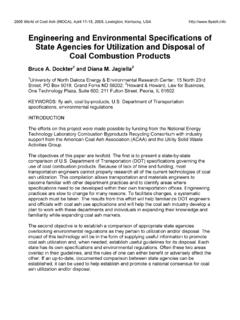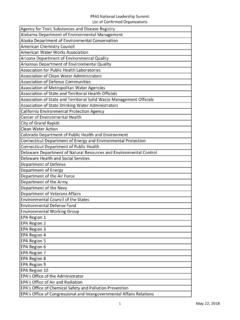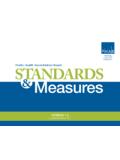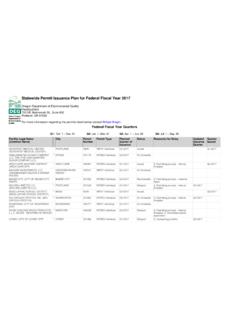Transcription of Compendium of State Regulatory Activities on …
1 California Colorado Hawaii Maine Maryland Massachusetts New Jersey New York Oregon Pennsylvania Texas Utah Washington Santiago, ChileTechnologySustainabilityHealthCompe ndium of State Regulatory Activities on Emerging of State Regulatory Activities on Emerging ContaminantsEmerging contaminants (ECs) present unique challenges. Sufficient information, by definition, has not been developed to fully understand risks to human health and the environment, and Regulatory science and policy decisions are often inconsistent or nonexistent. Within the , State agencies have authority for executing and overseeing environmental regulations. Variability in funding and risk Integral Consulting Inc. conducted a thorough evaluation of Regulatory EC initiatives in all 50 states and the District of Columbia.
2 Based on standardized research methods and one-on-one interviews with State Regulatory representatives, this extensive guide identifies agencies and departments addressing ECs, describes monitoring programs and other initiatives, and discusses current or pending actions. The Compendium is organized by State , followed by a list of acronyms and a detailed table of ECs for each State . MethodsState Regulatory initiatives for ECs were identified using the following methods: State -specific internet keyword searches Review of State agency websites Review of relevant open-source documents Phone surveys with State regulators, project managers, and staff using a standardized questionnaireStates were evaluated based on: Level of monitoring of scientific and Regulatory developments for ECs Level of environmental screening for specific ECs Development of Regulatory guidance or standards for ECs Establishment of a specific EC programmanagement strategies across the has led to differences in EC priorities and Regulatory actions.
3 This unpredictable landscape presents challenges for industry to comply with requirements, for the public to understand what levels in the environment are considered protective, and for various Regulatory and public health agencies to communicate risks to the public in a manner that promotes confidence and ActiveState has specific risk management programs addressing ECs. InactiveState relies exclusively on federal actions, guidance, and regulators are assessing scientific and Regulatory information on ECs and may have conducted response actions in a limited or site-specific manner, but have not implemented a statewide initiative. ActiveState has one or two initiatives or is beginning to gather State -specific information; however, it does not have an explicit program for ECs and does not devote significant resources to EC initiatives.
4 The map below provides a comparison of states based on their level of EC activity. FOR MORE INFORMATIONFor additional information, contact Janet Anderson, , DABT, at (830) 751-2434 or or Phil Goodrum, , DABT, at (315) 446-5090 or is up to date as of May 2016. Periodic revisions will be made. Only a limited number of states have begun to address ECs by establishing programs aimed at identification, screening, and/or prioritization and evaluation. Some states address ECs across their existing interdepartmental and interagency initiatives. Most states rely on EC occurrence and toxicity information from federal programs. Some states have additional environmental monitoring programs to expand the target analyte list and to increase the number of sample points in time and space.
5 A few states will also generate toxicity values if not generated by federal agencies or if the State toxicologists have a different interpretation of the available states will develop guidelines or standards for ECs despite significant data gaps in exposure or toxicity. How to compensate for existing data gaps varies considerably across State agencies. May 2016 This Compendium was independently developed and funded by Integral Consulting MattersMay 2016 For more information: view table of State ECs, or explore Integral s EC capabilities >Overarching State agency: ADEM>ADEM is comprised of six divisions KWater Division oversees operations of theIndustrial/Municipal Branch, Drinking Water Branch, Water Quality Branch, Office of Water Services, and Stormwater Management Branch >Drinking Water branch oversees surface watersource and groundwater source drinking water >ADEM promulgates MCLs for drinking watercontaminants under ADEM Administrative Code 335-7 >Alabama department of Public Health overseesthe Bureau of environmental ServicesState at a GlanceEmerging ContaminantsAlAbAmA Alabama department of environmental Management (ADEM) follows EPA UCMR Addresses ECs on a site-specific basis.
6 However, there is no formal EC program ADEM has addressed PFASs due to a site-specific environmental releasePesticides: Alabama is starting to address the occurrence of pesticides in surface water and fishthroughout the Spotlight for AlabamaState agencies and programs that manage environmental issuesHow Alabama addresses ECs >ADEM uses the EPA definition of ECs>ADEM follows the EPA unregulated chemical listdeveloped under UCMR >No current State target list of ECs>ADEM addresses ECs on a site-specific basis KADEM has taken specific action towardenvironmental contamination of PFASs due to a site-specific release >ADEM has stated that chlorpyrifos and dieldrin willbe included in environmental occurrence monitoring and fish tissue analysesMay 2016 For more information: view table of State ECs, or explore Integral s EC capabilities >Alaska department of environmental Conservation (ADEC) KPromulgates drinking water and groundwater cleanup levels (GCLs) >Division of Spill Prevention and Response KIncludes the Contaminated Sites Program and the Prevention and Emerging Response Program KHandles site-specific issues of contaminationState at a GlanceEmerging ContaminantsAlAskA Currently addresses ECs on a site-specific basis No formal EC program Has promulgated State -specific cleanup levels for a number of ECs1,4-Dioxane.
7 Alaska promulgated a GCL (2016) of 77 Spotlight for AlaskaState agencies and programs that manage environmental issuesHow Alaska addresses ECs >No active State program or single agency that manages ECs >Has implicitly defined ECs by highlighting sulfolane and PFASs >Monitors for pharmaceuticals as part of the Alaska Fish Monitoring Program >Addresses ECs primarily on a site-specific basis >Has developed GCLs for multiple ECsPFAss: Sampling and monitoring are ongoing at multiple sites across the 2016 May 2016 For more information: view table of State ECs, or explore Integral s EC capabilities >Arizona department of environmental Quality (ADEQ) KWater Quality Division KHazardous Waste Division KSolid Waste Management DivisionState at a GlanceEmerging ContaminantsArizonA Actively evaluating ECs through Advisory Panel on Emerging Contaminants (APEC) Has developed drinking water standards for a number of ECs Currently monitoring for ECs as practicable17-beta Estradiol.
8 This EC will be included in the APEC draft report on ECs and is slated to be a priority chemical for Spotlight for ArizonaState agencies and programs that manage environmental issuesHow Arizona addresses ECs >ADEQ convened APEC KCreated to advise ADEQ and water utilities on ECs and pathogens in drinking water sources KProvides a forum for discussion, planning, and prioritization of EC issues >Has formally defined ECs >Currently preparing a draft report on ECs found in Arizona waters, which will include: KA list of ECs that will be evaluated KInformation and recommendations for State utilities KRecommendations for the public KPharmaceutical drug take-back program information >Manages ECs in specific research and case-by-case situationsPhthalates: ADEQ has derived State drinking water standards for several phthalates not regulated by : This chemical has been detected in reclaimed water and is slated for inclusion in the APEC draft report on ECs as a priority chemical for 2016 For more information.
9 View table of State ECs, or explore Integral s EC capabilities >Arkansas department of environmental Quality KHazardous Waste Division implements State waste management programs KSolid Waste Management Division monitors groundwater near landfills >Water Quality Planning Branch KDevelops water quality standards for waterways KMonitors State surface water and groundwater KPrepares a biennial water quality assessment report > department of Health, Engineering Section, monitors the safety of public water systems using EPA standardsState at a GlanceEmerging ContaminantsArkAnsAs No formal State programs for monitoring or evaluating ECs State university has worked with USGS and others to examine ECs in north Arkansas streamsPharmaceuticals: Monitoring efforts in north Arkansas streams revealed frequent detections of caffeine, phenol, and para-cresol, among Spotlight for ArkansasState agencies and programs that manage environmental issuesHow Arkansas addresses ECs >No active State program or single agency that manages ECs >Has not formally defined ECs >University of Arkansas collaborated with USGS, USDA, and Agricultural Research Service KExamined occurrence of pharmaceuticals and other ECs in north Arkansas streams >No monitoring plannedMay 2016 May 2016 For more information: view table of State ECs, or explore Integral s EC capabilities >Overarching State agency.
10 California environmental Protection Agency >Office of environmental Health Hazard Assessment (OEHHA) KConducts risk evaluations for hazardous substances KIncludes numerous programs to assess hazards KProposition 65: Program intended to inform and protect people from potential carcinogens and developmental toxicants > State Water Resources Control Board (SWRCB) KSets State policy on water rights and quality control >Nine regional water quality control boards KResponsible for adoption and implementation of water quality basin plans KIssues water discharge requirements KPerforms water quality monitoring and control > department of Toxic Substances Control (DTSC) KEnvironmental restoration and enforcement of hazardous waste laws KEnvironmental Chemistry Lab performs extensive sampling and monitoring of chemicals in environmental samples, consumer products, and biological or human tissue samplesState at a GlanceEmerging ContaminantsCAliForniA Has formal Emerging environmental Challenges (EEC) Program Actively monitoring and evaluating multiple ECs: Proposition 65, State environmental monitoring, establishing provisional guidance values1,4-Dioxane: The drinking water notification level (1 g/L) triggers additional monitoring and response actions.







